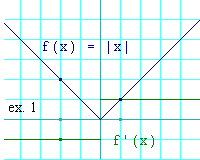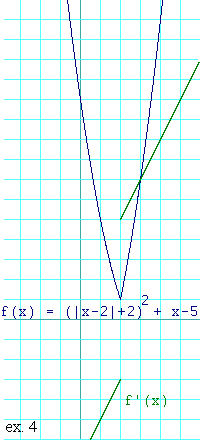Box 5.2-4: Solution to Exercise 5.2-4
© 1997 by Karl Hahn
Here's a problem that has a cusp without stationary points.
Again we have to deal with endpoints as well.
Here's the function again:
f(x) = (|x-2| + 2)2 + x - 5.

For review, here again is the graph of f(x) = |x|,
along with the graph of its derivative. Let's call its derivative,
abs'(x).
Notice again that abs'(x) is 1 for
x > 0 and is -1 for
x < 0.
Now we are ready to apply the
chain rule to the first summand of
our function. We need to find the derivative of
(|x-2| + 2)2.
Let g(h) = h2. Let
h(x) = |x-2| + 2. Then
g'(h) = 2h and
h'(x) = abs'(x-2).
What we want to take the derivative of here is g(h(x) ).
By the chain rule, we know that this
derivative is:
g'(h(x) )h'(x) = 2h(x) h'(x) = 2(|x-2| + 2) abs'(x-2)
So taking the entire derivative of
f(x) = (|x-2| + 2)2 + x - 5 is simply
a matter of adding an easy term (i.e., the derivative of
x - 5)
to what we've done so far:
f'(x) = 2(|x-2| + 2) abs'(x-2) + 1
 Here is the graph of this f(x) and f'(x). Observe
that all the nastiness of this function takes place at
x = 2. Everywhere else, the behavior of this
function is quite ordinary. Therefore, just as with the last one,
it makes sense to break this
problem up into two regions, x < 2 and
x > 2 , and deal with the two regions separately.
Here is the graph of this f(x) and f'(x). Observe
that all the nastiness of this function takes place at
x = 2. Everywhere else, the behavior of this
function is quite ordinary. Therefore, just as with the last one,
it makes sense to break this
problem up into two regions, x < 2 and
x > 2 , and deal with the two regions separately.
In the region of x < 2 it is true that
|x-2| = 2 - x and
|x-2| + 2 = 4 - x. So in this region, it is true
that f(x) = (4 - x)2 + x - 5 = x2 - 7x + 11.
If we take the derivative in this region, we get
f'(x) = 2x - 7. To find any stationary points, we
solve for f'(x) = 0, and we find a stationary point
at x = 3.5. Of course we need only consider it
if it is in the region x < 2, and it is not.
So our only candidate for a stationary point in this region is a dud, and
we have to throw it out.
Now for the other region, where x > 2. In this
region, |x-2| = x - 2 and
|x-2| + 2 = x. Therefore, in this region it
is true that
f(x) = x2 + x - 5.
Here, when we take the derivative, we find
f'(x) = 2x + 1. Solving for
f'(x) = 0, we find that we expect a stationary
point at x = -0.5. This point again is not in the
region we are examining (that is x > 2), and so
again we have to discard it as a candidate for being a stationary point.
So now we know that this function has no stationary points.
But we also know this function has a
cusp. How do we know that? Because its derivative is discontinuous
and the discontinuity passes though zero. On the graph, you can see that
f'(x) goes from -3 as x approaches 2 from
below to 5 as x approaches 2 from above. So
indeed it does jump through zero. And as you go through the jump
from left to right, it is an increasing jump. By the rule we discussed in
the first problem, this means that x = 2 must be
a local minimum. It is easy to plug 2 in for x and
discover that f(2) = 1. So we have a local minimum
at (2, 1).
Finally we have to evaluate the endpoints, x = -4 and
x = 8. Here are the evaluations at the endpoints:
left right
f(-4) = -55 f(8) = 67
f'(-4) = -15 f'(8) = 17
By endpoint rules we discussed in problem 1, we can see that both
(-4, -55) and (8, 67) are
local maximums.
Return to Main Text
email me at hahn@netsrq.com



 Here is the graph of this f(x) and f'(x). Observe
that all the nastiness of this function takes place at
Here is the graph of this f(x) and f'(x). Observe
that all the nastiness of this function takes place at